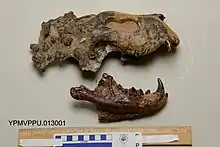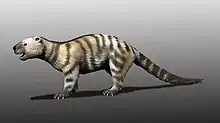| Oxyaenidae | |
|---|---|
 | |
| skull of Palaeonictis occidentalis | |
 | |
| reconstruction of Patriofelis ferox | |
| Scientific classification | |
| Domain: | Eukaryota |
| Kingdom: | Animalia |
| Phylum: | Chordata |
| Class: | Mammalia |
| Mirorder: | Ferae |
| Clade: | Pan-Carnivora |
| Order: | †Oxyaenodonta Van Valen, 1971[1] |
| Family: | †Oxyaenidae Cope, 1877[2] |
| Type genus | |
| †Oxyaena Cope, 1874 | |
| Subfamilies | |
| Synonyms | |
|
synonyms of order:
synonyms of family:
| |
Oxyaenidae ("sharp hyenas") is a family of extinct carnivorous placental mammals.[3] Traditionally classified in order Creodonta, this group is now classified in its own order Oxyaenodonta ("sharp tooth hyenas") within clade Pan-Carnivora in mirorder Ferae. The group contains four subfamilies comprising fourteen genera. Oxyaenids were the first to appear during the late Paleocene in North America, while smaller radiations of oxyaenids in Europe and Asia occurred during the Eocene.[4]
Etymology
The name of order Oxyaenodonta comes from Ancient Greek ὀξύς- (oxús-) 'sharp', name of hyena genus Hyaena and from Ancient Greek ὀδούς (odoús) 'tooth'.
The name of family Oxyaenidae comes from Ancient Greek ὀξύς- (oxús-) 'sharp', name of hyena genus Hyaena and taxonomic suffix "-idae".[5]
Description
They were superficially cat-like mammals that walked on flat feet, in contrast to modern cats, which walk and run on their toes. Anatomically, characteristic features include a short, broad skull, deep jaws, and teeth designed for crushing rather than shearing, as in the hyaenodonts or modern cats.
Oxyaenids were specialized carnivores that preyed on other terrestrial vertebrates, eggs and insects. They were capable of climbing trees, which is suggested by fossil evidence of their paws.
Classification and phylogeny
Taxonomy
- Family: †Oxyaenidae (Cope, 1877)
- Subfamily: †Machaeroidinae (Matthew, 1909)
- Genus: †Apataelurus (Scott, 1937)
- †Apataelurus kayi (Scott, 1937)
- †Apataelurus pishigouensis (Tong & Lei, 1986)
- Genus: †Diegoaelurus (Zack, Poust & Wagner, 2022)[6]
- Diegoaelurus vanvalkenburghae (Zack, Poust & Wagner, 2022)
- Genus: †Isphanatherium (Lavrov & Averianov, 1998)
- Isphanatherium ferganensis (Lavrov & Averianov, 1998)
- Genus: †Machaeroides (Matthew, 1909)
- †Machaeroides eothen (Matthew, 1909)
- †Machaeroides simpsoni (Dawson, 1986)
- Genus: †Apataelurus (Scott, 1937)
- Subfamily: †Oxyaeninae (Cope, 1877)
- Genus: †Argillotherium (Davies, 1884)
- †Argillotherium toliapicum (Davies, 1884)
- Genus: †Dipsalidictis (Matthew & Granger, 1915)
- †Dipsalidictis aequidens (Matthew & Granger, 1915)
- †Dipsalidictis krausei (Gunnell & Gingerich, 1991)
- †Dipsalidictis platypus (Matthew & Granger, 1915)
- †Dipsalidictis transiens (Matthew & Granger, 1915)
- Genus: †Malfelis (Stucky & Hardy, 2007)[7]
- †Malfelis badwaterensis (Stucky & Hardy, 2007)
- Genus: †Oxyaena (Cope, 1874)
- †Oxyaena forcipata (Cope, 1874)
- †Oxyaena gulo (Matthew & Granger, 1915)
- †Oxyaena intermedia (Denison, 1938)
- †Oxyaena lupina (Cope, 1874)
- †Oxyaena pardalis (Matthew & Granger, 1915)
- †Oxyaena simpsoni (Van Valen, 1966)
- †Oxyaena woutersi (Lange-Badré & Godinot, 1982)
- Genus: †Patriofelis (Leidy, 1870)
- †Patriofelis ferox (Marsh, 1872)
- †Patriofelis ulta (Leidy, 1870)
- Genus: †Protopsalis (Cope, 1880)
- †Protopsalis tigrinus (Cope, 1880)
- Genus: †Sarkastodon (Granger, 1938)
- †Sarkastodon henanensis (Tong & Lei, 1986)
- †Sarkastodon mongoliensis (Granger, 1938)
- Genus: †Argillotherium (Davies, 1884)
- Subfamily: †Palaeonictinae (Denison, 1938)
- Genus: †Ambloctonus (Cope, 1875)
- †Ambloctonus major (Denison, 1938)
- †Ambloctonus priscus (Matthew & Granger, 1915)
- †Ambloctonus sinosus (Cope, 1875)
- Genus: †Dipsalodon (Jepsen, 1930)
- †Dipsalodon churchillorum (Rose, 1981)
- †Dipsalodon matthewi (Jepsen, 1930)
- Genus: †Palaeonictis (de Blainville, 1842)
- †Palaeonictis gigantea (de Blainville, 1842)
- †Palaeonictis occidentalis (Osborn, 1892)
- †Palaeonictis peloria (Rose, 1981)
- †Palaeonictis wingi (Chester, 2010)
- Genus: †Ambloctonus (Cope, 1875)
- Subfamily: †Tytthaeninae (Gunnell & Gingerich, 1991)
- Genus: †Tytthaena (Gingerich, 1980)
- †Tytthaena lichna (Rose, 1981)
- †Tytthaena parrisi (Gingerich, 1980)
- Genus: †Tytthaena (Gingerich, 1980)
- Subfamily: †Machaeroidinae (Matthew, 1909)
Phylogeny
Cladogram according to Gunnel in 1991:[8]
| Oxyaenidae |
| ||||||||||||||||||||||||||||||||||||||||||||||||||||||||||||||||||||||||
See also
References
- ↑ Van Valen, Leigh (1971). "Adaptive Zones and the Orders of Mammals". Evolution. 25 (2): 420–428. doi:10.1111/j.1558-5646.1971.tb01898.x. PMID 28563121.
- ↑ E. D. Cope (1877.) "Report upon the extinct Vertebrata obtained in New Mexico by parties of the expedition of 1874." Report upon United States Geographical Surveys West of the One Hundredth Meridian, in charge of First Lieut. G.M. Wheeler, Corps of Engineers, U.S. Army, Vol. IV Paleontology, Part II, pp. 1-365. Government Printing Office, Washington, D.C.
- ↑ Halliday, Thomas J. D.; Upchurch, Paul; Goswami, Anjali (2015). "Resolving the relationships of Paleocene placental mammals" (PDF). Biological Reviews. 92 (1): 521–550. doi:10.1111/brv.12242. ISSN 1464-7931. PMC 6849585. PMID 28075073.
- ↑ Gunnel, Gregg F.; Gingerich, Philip D. (30 Sep 1991). "Systematics and evolution of late Paleocene and early Eocene Oxyaenidae (Mammalia, Creodonta) in the Clarks Fork Basin, Wyoming" (PDF). Contributions from the Museum of Paleontology. The University of Michigan. 28 (7): 141–180. Retrieved 2010-01-03.
- ↑ Dixon, Dougal (2008). World Encyclopedia of Dinosaurs & Prehistoric Creatures. Lorenz Books. ISBN 978-0754817307.
- ↑ Zack, Shawn P.; Poust, Ashley W.; Wagner, Hugh (2022-03-15). "Diegoaelurus, a new machaeroidine (Oxyaenidae) from the Santiago Formation (late Uintan) of southern California and the relationships of Machaeroidinae, the oldest group of sabertooth mammals". PeerJ. 10: e13032. doi:10.7717/peerj.13032. ISSN 2167-8359. PMC 8932314. PMID 35310159. S2CID 247480756.
- ↑ Stucky, R. K.; Hardy, T. G. (2007). "A new large hypercarnivorous oxyaenid (Mammalia, Creodonta) from the Middle Eocene of the Wind River Formation, Natrona County, Wyoming" (PDF). Bulletin of Carnegie Museum of Natural History. 39: 57–65. doi:10.2992/0145-9058(2007)39[57:anlhom]2.0.co;2. S2CID 130956705.
- ↑ Gunnel, Gregg F.; Gingerich, Philip D. (1991). "Systematics and evolution of late Paleocene and early Eocene Oxyaenidae (Mammalia, Creodonta) in the Clarks Fork Basin, Wyoming" (PDF). Contributions from the Museum of Paleontology. The University of Michigan. 28 (7): 141–180.
Further reading
- David Lambert and the Diagram Group. The Field Guide to Prehistoric Life. New York: Facts on File Publications, 1985. ISBN 0-8160-1125-7